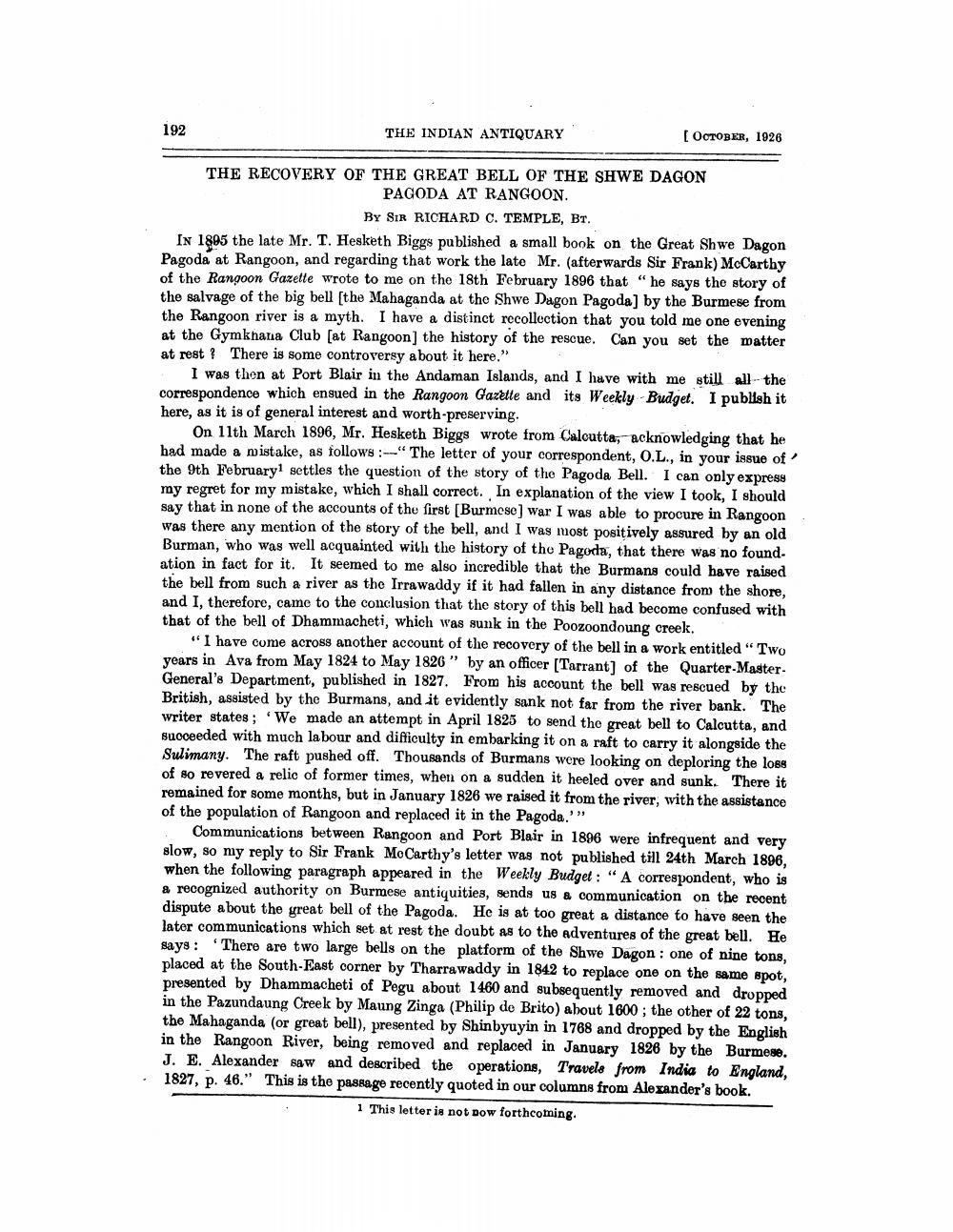________________
192
THE INDIAN ANTIQUARY
(OCTOBER, 1926
THE RECOVERY OF THE GREAT BELL OF THE SHWE DAGON
PACODA AT RANGOON.
BY SIR RICHARD C. TEMPLE, BT. IN 1895 the late Mr. T. Hesketh Biggs published a small book on the Great Shwe Dagon Pagoda at Rangoon, and regarding that work the late Mr. (afterwards Sir Frank) McCarthy of the Rangoon Gazette wrote to me on the 18th February 1896 that " he says the story of the salvage of the big bell (the Mahaganda at the Shwe Dagon Pagoda) by the Burmese from the Rangoon river is a myth. I have a distinct recollection that you told me one evening at the Gymkhana Club [at Rangoon) the history of the rescue. Can you set the matter at rest? There is some controversy about it here."
I was then at Port Blair in the Andaman Islands, and I have with me still all - the correspondence which ensued in the Rangoon Gazelle and its Weekly Budget. I publish it here, as it is of general interest and worth-preserving.
On 11th March 1896, Mr. Hesketh Biggs wrote from Calcutta, acknowledging that he had made a mistake, as follows:-"The letter of your correspondent, O.L., in your issue of the 9th February1 settles the question of the story of the Pagoda Bell. I can only express my regret for my mistake, which I shall correct. In explanation of the view I took, I should say that in none of the accounts of the first (Burmese) War I was able to procure in Rangoon was there any mention of the story of the bell, and I was most positively assured by an old Burman, who was well acquainted with the history of the Pagoda, that there was no found. ation in fact for it. It seemed to me also incredible that the Burmang could have raised the bell from such a river as the Irrawaddy if it had fallen in any distance from the shore, and I, therefore, came to the conclusion that the story of this bell had become confused with that of the bell of Dhammacheti, which was sunk in the Poozoondoung creek.
"I have come across another account of the recovery of the bell in a work entitled "Two years in Ava from May 1824 to May 1826" by an officer (Tarrant) of the Quarter Master General's Department, published in 1827. From his account the bell was rescued by the British, assisted by the Burmans, and it evidently sank not far from the river bank. The writer states; We made an attempt in April 1825 to send the great bell to Calcutta, and suoceeded with much labour and difficulty in embarking it on a raft to carry it alongside the Sulimany. The raft pushed off. Thousands of Burmans were looking on deploring the loss of 80 revered a relio of former times, when on a sudden it heeled over and sunk. There it remained for some months, but in January 1826 we raised it from the river, with the assistance of the population of Rangoon and replaced it in the Pagoda.'”
Communications between Rangoon and Port Blair in 1896 were infrequent and very slow, so my reply to Sir Frank MoCarthy's letter was not published till 24th March 1896, when the following paragraph appeared in the Weekly Budget: "A correspondent, who is & recognized authority on Burmese antiquities, sends us a communication on the recent dispute about the great bell of the Pagoda. He is at too great a distance to have seen the later communications which set at rest the doubt as to the Adventures of the great bell. He says: 'There are two large bells on the platform of the Shwe Dagon: one of nine tons, placed at the South-East corner by Tharrawaddy in 1842 to replace one on the same spot, presented by Dhammacheti of Pegu about 1460 and subsequently removed and dropped in the Pazundaung Creek by Maung Zinga (Philip de Brito) about 1600; the other of 22 tons, the Mahaganda (or great bell), presented by Shinbyuyin in 1768 and dropped by the English in the Rangoon River, being removed and replaced in January 1826 by the Burmese.
J. E. Alexander saw and described the operations, Travels from India to England, • 1827, p. 46." This is the passage recently quoted in our columns from Alexander's book.
1 This letter is not now forthcoming.




